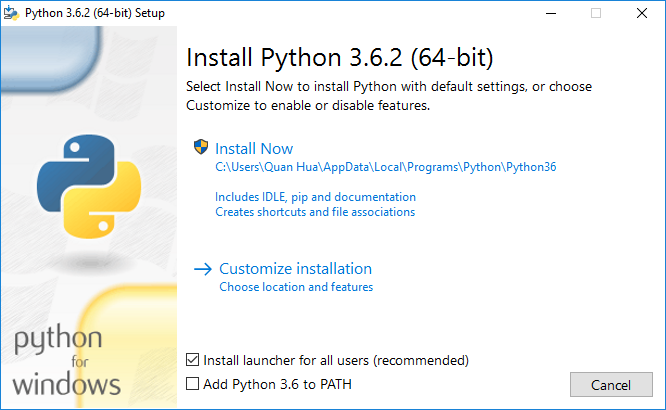
- COMMAND TO INSTALL TENSORFLOW UBUNTU PYTHON 3.6 HOW TO
- COMMAND TO INSTALL TENSORFLOW UBUNTU PYTHON 3.6 INSTALL
- COMMAND TO INSTALL TENSORFLOW UBUNTU PYTHON 3.6 UPDATE
Tools like P圜harm will detect and make use of the interpreter of your project. Installing TensorFlow 2.1.0 with Keras 2.2.4 for CPU on Windows 10 with Anaconda 5.2.0 for Python 3.6.5 Posted on Apby jamesdmccaffrey Installing TensorFlow (which contains Keras) is a minor software nightmare due mostly to version incompatibilities with the over 500 packages and over 50,000 files involved. Remember to activate your virtual environment from the command line if you want to use the Python3.6 interpreter of your project.
COMMAND TO INSTALL TENSORFLOW UBUNTU PYTHON 3.6 INSTALL
# Install tensorflow and other libraries required by your project # python interpreter of your virtual environment # At this point, every python program and command that your run will use the

Mkdir folder-for-my-project & cd folder-for-my-project sudo apt install python3-venv python3-dev. Isn't this achievable by upping the ubuntu version to 18.04 in spec. It is an open-source platform for machine learning and artificial intelligence.
COMMAND TO INSTALL TENSORFLOW UBUNTU PYTHON 3.6 HOW TO
# If you do not have a folder for your project, just create one Step-wise installation: Step 1: Create a virtual environment for the python venv model. +1 Would appreciate tensorflow maintained docker images with python 3.6 and ubuntu 18.04 (if it has to be ubuntu, a smaller image would be nice). Learn how to install TensorFlow on Ubuntu 20.04 in a Python virtual environment. Sudo apt install -y python3.6 python3.6-venv Install Python 3.6 sudo apt install -y python3.6 python3.6-venv If you do not have a folder for your project, just create one mkdir folder-for-my-project & cd folder-for-my-project Create the virtual environment python3.6 -m venv venv Activate the virtual environment source. If I'm not mistaken, Tensorflow supports Python 3.6: # Install Python 3.6
COMMAND TO INSTALL TENSORFLOW UBUNTU PYTHON 3.6 UPDATE
I'm now running Ubuntu 20.04 with python 3.8.5, I've already done this : sudo add-apt-repository ppa:deadsnakes/ppa followed by : sudo apt-get update sudo apt-get install python3. All in all, use Virtual Environments.įor example, the following instructions will create a virtual environment for your project using Python 3.6. No install necessaryrun the TensorFlow tutorials directly in the browser with Colaboratory, a Google research project created to help disseminate machine learning education and research. I'm trying to install an older version of tensorflow and it needs python3.6 to support the whl file of installation. In this tutorial you will learn how to install Python 3.8 on Ubuntu 18.04 or Ubuntu 20.04.

It’s versatile enough for use in web development and app design.

If you do not install Python libraries on your system, you will avoid the chance to have a library mess on your system. Python is a popular programming language often used to write scripts for operating systems. When working with Python, it is a good practice to use a Virtual Environment that will isolate the libraries used by your project by the libraries of the system. At the repositories of Ubuntu 20.04 you can find other versions of Python, for example, Python 3.6.


 0 kommentar(er)
0 kommentar(er)
